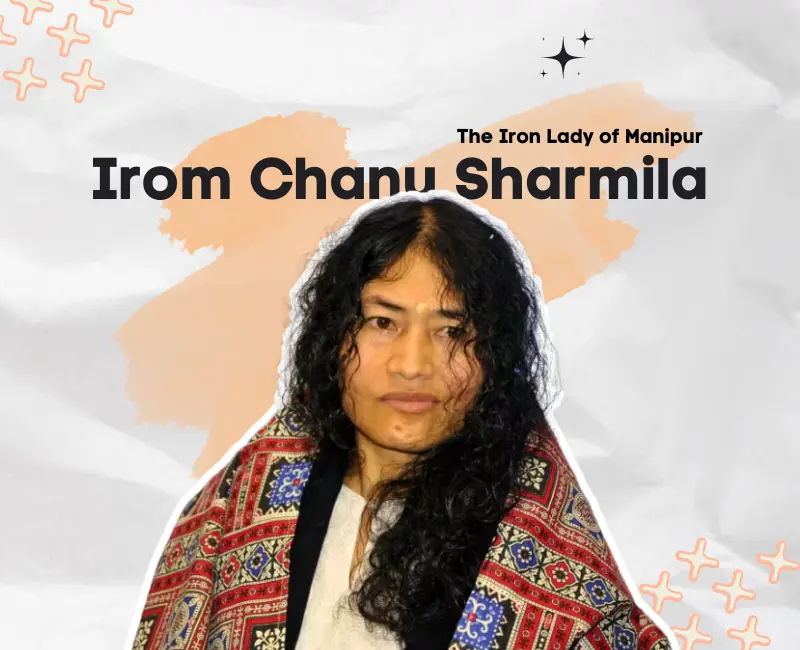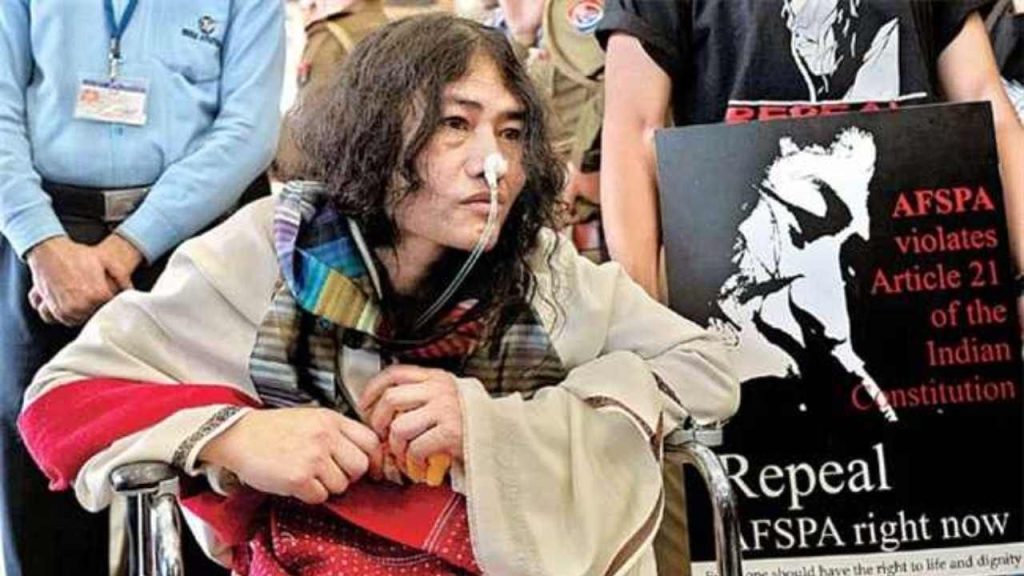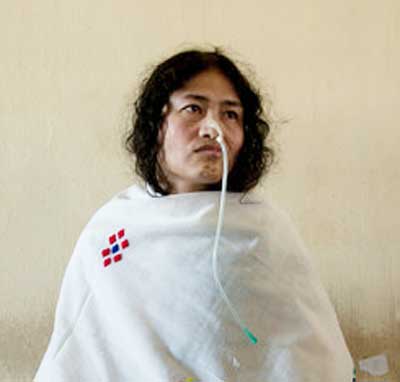Irom Chanu Sharmila: Exploring the Journey of the Iron Lady of Manipur

Irom Chanu Sharmila, known as the “Iron Lady of Manipur,” is a moniker associated with grit, determination, and unshakable resolve. Her life story highlights the power of peaceful protest and the resilience of the human spirit.
Sharmila’s journey is more than just one woman’s story; it reflects the struggles of the people of Manipur and the giant fight against injustice in India.
This article explores her biography further, including her 16-year hunger strike and her impact on India’s sociopolitical scene.
Early Life and Activism Beginnings
Irom Chanu Sharmila was born on March 14, 1972, in Kongpal, a small village in Imphal, Manipur. She was the youngest of nine siblings, born into a family that valued education and social justice.
Sharmila was deeply aware of the socio-political issues affecting her state from a young age. Manipur, like many parts of Northeast India, has a history of armed conflict and has been under the shade of the Armed Forces (Special Powers) Act (AFSPA) since 1958.
The Act grants extraordinary powers to the Indian armed forces, including the right to arrest without a warrant and shoot to kill under certain circumstances, which has led to widespread human rights abuses in the region.
Sharmila was acutely aware of the suffering of her people growing up in this environment. She was a quiet child, often described as introspective, but her early years were marked by a deep-seated desire to give to the betterment of her community.
After completing her schooling, Sharmila became involved in various social and political causes, working with local NGOs and participating in movements that sought to address the grievances of the people of Manipur.
The seeds of dissent were sown early in Sharmila when, in 2000, a fateful incident occurred. Indian troops opened fire on a bus at Malom, killing ten civilians. This event catalyzed a transformation in the young woman.
A Turning Point Led to The Malom Massacre
The turning point in Sharmila’s life came on November 2, 2000, when ten civilians, including women and children, were gunned down by the Assam Rifles, a paramilitary force, in Malom, a small town in Manipur. This incident, known as the Malom Massacre, was one of the many instances of extrajudicial killings that had become all too common in the region under AFSPA.
The massacre deeply affected Sharmila, who decided that enough was enough. On November 5, 2000, just three days after the massacre, she began her hunger strike, demanding the repeal of AFSPA.

Her decision to go on a hunger strike was not taken lightly; she knew it would be a long and challenging battle, but she was determined to bring attention to the plight of her people.
She was determined to use her body as a weapon of protest, a silent yet powerful indictment of the state’s excesses. For sixteen long years, she subsisted solely on water, her frail body a stark contrast to the iron will that sustained her.
Imprisoned and force-fed, Sharmila’s ordeal became a global cause célèbre. Her story ignited a fire of solidarity, with human rights activists and ordinary people rallying behind her.
Yet, despite the immense pressure, the Indian government remained steadfast in its refusal to revoke AFSPA.
The Beginning of the Hunger Strike
Sharmila’s hunger strike was unique in many ways. It was a nonviolent protest inspired by Mahatma Gandhi’s philosophy of Satyagraha, but it was also one of the most extended hunger strikes in recorded history.
For Sharmila, the hunger strike was not just a protest but a form of penance for her people’s suffering. She vowed not to eat or drink anything until AFSPA was repealed.

On the day she began her strike, Sharmila took a vow of silence and refused all food and water. Her decision to abstain from even water made her protest particularly dangerous, as it posed a severe risk to her health.
Within days, she was arrested by the Manipur police on charges of attempting suicide, a crime under Indian law. She was then forcibly nasal-fed to keep her alive.
Though Sharmila’s fast did not immediately lead to the repeal of AFSPA, it undeniably brought the issue into sharp focus.
It sparked a national conversation about the use of excessive force by the armed forces and the degradation of civil liberties in the name of security. Her courage inspired countless others to raise their voices against injustice.
The Struggle Against AFSPA
Her protest drew the attention of human rights organizations, activists, and media worldwide.
However, despite the international attention, the Indian government refused to repeal AFSPA, arguing that it was necessary to maintain law and order in the conflict-ridden region.
Sharmila’s protest was not just a fight against AFSPA; it was a fight for the dignity and rights of the people of Manipur.

Over the years, her strike symbolized resistance against state oppression. Despite being confined to a hospital room for most of her protest, where she was forcibly fed through a nasal tube, Sharmila remained steadfast in her resolve.
Her strength and determination earned her the “Iron Lady of Manipur.”
Challenges and Criticisms Faced by The Iron Lady
While Sharmila’s protest was widely lauded, it was not without its challenges and criticisms. Some questioned the effectiveness of her hunger strike, arguing that it had failed to achieve its primary objective – the repeal of AFSPA. Others criticized her for what they saw as an unrealistic and uncompromising stance.
Sharmila herself faced immense personal challenges. For 16 years, she lived in isolation, cut off from her family and friends. She was not allowed to meet her supporters freely, and her life was under constant surveillance.
The physical toll of the hunger strike was also severe; prolonged nasal feeding led to various health complications, including severe gastric issues and osteoporosis.
Despite these challenges, Sharmila remained resolute. Her protest was driven by a deep sense of responsibility towards her people, and she believed that her struggle was necessary to bring about change.
Impact on Manipur and Beyond
Sharmila’s hunger strike profoundly impacted the people of Manipur and beyond. It brought international attention to the issue of AFSPA and the human rights abuses in Northeast India.
Her protest also inspired many others to join the fight against AFSPA, forming various civil society organizations and movements that continue to advocate for its repeal.
In Manipur, Sharmila became a symbol of resistance and hope. Her hunger strike united people from different communities in the fight against oppression.
Even though AFSPA remains in place, Sharmila’s protest succeeded in highlighting the need for justice and accountability in the region.
The End of the Hunger Strike
On August 9, 2016, after 16 years of fasting, Sharmila ended her hunger strike. Her decision was met with mixed reactions.
While some saw it as a betrayal of her cause, others understood the immense toll the hunger strike had taken on her and supported her decision.
Sharmila announced that she would end her strike to enter politics and continue her fight against AFSPA through democratic means.
She expressed her desire to become the Chief Minister of Manipur and work from within the system to bring about change.
Political Journey
Following the end of her hunger strike, Sharmila formed her political party, the People’s Resurgence and Justice Alliance (PRJA).
She contested the 2017 Manipur Legislative Assembly elections from the Thoubal constituency, where she ran against the then CM of Manipur, Okram Ibobi Singh.
Despite the widespread media coverage and the support of various civil society groups, Sharmila’s political debut could have been more successful. She received only 90 votes, a result that left her disheartened.
However, Sharmila’s entry into politics was significant, as it marked a shift in her approach to activism. While her hunger strike had been a protest, her political journey was an attempt to work within the system to bring about change.
Life After Politics
After her defeat in the 2017 elections, Sharmila announced her decision to step back from public life.
She married her long-time partner, Desmond Coutinho, a British citizen of Goan descent, and moved to Kerala.
In the following years, Sharmila has remained mainly out of the public eye, focusing on her personal life and writing.
While Sharmila’s withdrawal from public life marked the end of an era, her legacy continues to inspire.
Her 16-year hunger strike remains one of modern history’s most potent symbols of non-violent resistance. Her fight against AFSPA resonates with activists and human rights defenders worldwide.
Legacy and Influence
Irom Chanu Sharmila’s legacy is not just about her 16-year hunger strike; it is about her unwavering commitment to justice, her courage in the face of adversity, and her belief in the power of peaceful protest.
She has been compared to Mahatma Gandhi for her use of nonviolent resistance, and her struggle has been compared to that of other global human rights icons.
In Manipur, Sharmila is revered as a hero. Her protest has inspired a generation of activists and has brought international attention to the plight of the people of Northeast India.
Even though AFSPA remains in place, Sharmila’s protest succeeded in highlighting the human rights abuses in the region and in keeping the issue alive in public discourse.
Global Recognition
Sharmila’s protest has earned her recognition both in India and internationally. She has received numerous awards for courage and dedication, including the Gwangju Prize for Human Rights in 2007.
The prize is given to individuals or organizations significantly advancing human rights, democracy, and peace.
Her story has also been the subject of several books, documentaries, and plays, further cementing her place in history as one of India’s most prominent human rights activists.
Continuing the Fight Against AFSPA
The fight against AFSPA is far from over. While Sharmila may have ended her hunger strike and stepped back from public life, the movement she helped to galvanize continues.
Various civil society groups, activists, and human rights organizations continue to advocate for the repeal of AFSPA, drawing inspiration from Sharmila’s protest.
Some positive developments have occurred in recent years, such as the partial lifting of AFSPA from certain areas in Northeast India.
However, the Act remains in force in several states, and the fight for justice and accountability continues.
Conclusion
Irom Chanu Sharmila is more than just a name; she embodies courage, resilience, and hope.
Her fast unto death was a stark indictment of a system gone wrong, and her legacy is a call to action for all those who believe in a just and equitable society.
As we grapple with the challenges of our time, Sharmila’s story serves as a beacon, reminding us that even in the darkest of hours, the human spirit can prevail.


